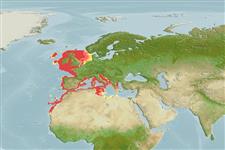Classificação / Names
Common names from other countries
Referência principal
Tamanho / Peso / Idade
Max length : 120 cm TL macho/indeterminado; (Ref. 41333); 125.0 cm TL (female); Peso máx. publicado: 14.3 kg (Ref. 40637)
Length at first maturity
Lm 91.7, range 60 - ? cm
Ambiente
; marinhas demersal; intervalo de profundidade 10 - 380 m (Ref. 6808)
Clima / Intervalo
Temperate, preferred 14°C (Ref. 107945); 60°N - 21°N, 18°W - 24°E
Distribuição
Descrição breve
Espinhos dorsais (total): 0; Espinhos anais 0; Raios anais moles: 0. Upper surface wholly prickly, except in juveniles; underside only prickly along front margins of disc; orbital thorns separate; a regular median row of 40-45 thorns in juveniles and adult females, interrupted on back in males; 60-90 tooth rows; upper surface ochre, with numerous small dark spots to margins of disc, underside white (Ref. 3167).
Categoria na Lista Vermelha da IUCN (Ref. 115185)
Ameaça para o homem
Harmless
Utilização humana
Pescarias: pouco comercial; peixe desportivo: sim
Mais informação
ReferênciasAquaculturaPerfil para aquaculturaEstirpesGenéticaFrequência dos alelosHereditariedadeDoençasProcessamentoMass conversion
Ferramentas
Relatórios especiais
Descarregue XML
Fontes da internet
Estimates of some properties based on models
Phylogenetic diversity index
PD50 = 0.5000 many relatives (e.g. carps) 0.5 - 2.0 few relatives (e.g. lungfishes)
Nível Trófico
3.8 ±0.61 se; Based on food items.
Resiliência
Baixo, tempo mínimo de duplicação da população 4,5 - 14 anos (K=0.12-0.19; tmax=15; Fec=40)
Vulnerabilidade
High vulnerability (59 of 100)
Categoria de preço
